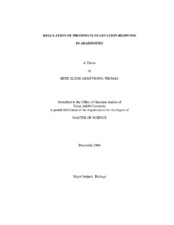| dc.description.abstract | Phosphate is an essential but limited macronutrient for all plants. In response to
limited levels of phosphate, plants have developed highly specialized developmental,
biochemical, and molecular responses. To further expand our knowledge of the
phosphate starvation induced signal transduction pathway in plants, the expression of the
phosphate starvation inducible Purple Acid Phosphatase 1 (PAP1) gene was studied in
transgenic Arabidopsis. While few components have been identified regulating gene
expression under phosphate starvation conditions in plants, one cis regulatory element
recognized by the MYB transcriptions factor Phosphate Starvation Response 1 (PHR1)
has been identified in many phosphate starvation induced (PSI) genes. PAP1 and many
other genes examined during the course of the mutant characterization contain this cis
element.
Using the GUS reporter gene under control of the PAP1 promoter, a mutant
screen was devised for plants showing abnormal PAP1 response to phosphate nutrition.
Three mutant lines were identified and subsequently characterized for the phosphate
starvation-induced signal-transduction pathway in Arabidopsis.
Two mutants, BT1 and BT2, both with dominant mutations, showed increased
GUS staining. The mutations in BT1 and BT2 are tightly linked to the transgene and to
each other, but complementation analysis suggested that they are in different genes.
Characterization of these mutants indicated that the PSI genes PAP1 and At4 (in BT1
roots), and RNS1 (in BT2 leaves) have alternative or additional methods of regulation
other than PHR, even though these genes all contain PHR1 binding sites. A third mutant, BT3, had a phenotype similar to the PAP1 null-mutant and did
not show PAP1 phosphatase activity under normal soil-grown conditions.
Characterization of BT3 indicates that PAP1, RNS1, and AtIPS1 are not exclusively
regulated by PHR1.
In an attempt to map the BT3 mutant in a Columbia background by crossing with
Landsberg erecta (Ler), it was discovered that the Ler ecotype does not show PAP1
phosphatase activity under normal soil-grown conditions. The PAP1 phosphatase
regulatory trait, named BT5, was mapped to a 15,562 bp-region area containing only two
genes between the GPA1 and ER markers on Chromosome 2. | en |


